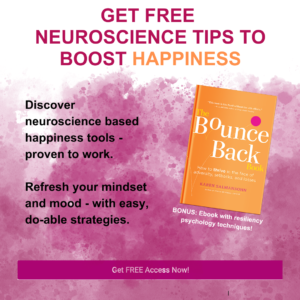
You might think you mindfully choose whatever you do on a given day – but think again. Around 40 to 45 percent of your daily actions are actually preprogrammed habits. With this in mind, if you want to live your happiest life, it makes sense that you take the time to prep your brain with better habit programming. Because the better your 40 to 45 percent preprogrammed daily habits are, then the better your entire life will be.
So, coming up I’m going to give you some simple tweaks to help you to preprogram your brain with more positive daily habits. Each of these tweaks are based in habit formation research – plus tested by me personally. And I definitely became happier when I began embracing these small habit shifts. (Plus, these tips helped me to lower my cholesterol and increase my income too!)
Remember: The sum of your habits has a big influence on your life. The better your habits, the better your life. Here’s how you can retrain your brain for more joy, health, love, and success.
TIP 1: Start with Keystone Habits
If you want to supercharge your life with positive change, it’s smart to start by changing what The Power of Habit author Charles Duhigg calls your “Keystone Habits.”
A Keystone Habit is a habit that creates such a huge change in your life that you wind up transforming your overall sense of identity.
As a result, your boosted mood and self-esteem create a ripple effect into other areas of your life. Soon you’ll wind up wanting to improve even more habits.
Think of a keystone habit as that one domino that, once tipped, causes a ripple effect, setting off many others.
For example…
Let’s take the habit of daily planning. If you start each day – or end each night – by planning your tasks for the next day, this seemingly simple action can transform your life dramatically.
Here’s how: You begin by increasing your organizational skills. Next thing you know, your improved organization reduces daily stress because you’re no longer scrambling last minute. This reduction in stress can lead to better focus and a calmer mindset, which might make you more effective at work and more present at home.
Or consider the habit of daily learning or reading. When you commit to learning something new every day, you’re not just accumulating knowledge. This habit increases your curiosity, which fuels creativity and problem-solving skills. Over time, this can lead to career advancements or new personal projects, boosting your confidence and satisfaction in life.
In essence, a keystone habit is like the lead singer of a band—the one that may get all the glory, but really, it’s the catalyst that brings the entire band (or your life’s habits) into harmony. Once you’ve got that lead habit rocking, the rest of the habits join in tune, and soon, you’ve got a symphony of productivity, health, and happiness playing in your life.
With this in mind, I recommend bookending your day with positive Keystone Habits. This brings me to my next tip.
TIP 2: Create Positive Morning and Evening Habits
Beginning and ending your day with a positive Keystone Habit can have an awesome ripple effect impact on the next twenty-four hours of your life.
For example…
If you work out in the morning, researchers from Brigham Young University discovered that for the rest of the day, you’ll find snacking to be less tempting, and you’ll be more active in general.
If you do a gratitude practice before bedtime, a study in the Journal of Psychosomatic Research found that you’ll sleep better and will often wake up the next morning feeling more refreshed and in a more positive frame of mind.
TIP 3: Obviousness Is a Great Motivator
Whatever new habit you choose to embrace, be sure to make it highly specific and easily measurable.
For example…
Do not say: “I want to eat better.” This is basically code for: “I don’t want to commit to anything in a specific way.”
Say instead: “I will start eating vegetables and fruits for snacks.”
Basically, when you’re crystal clear about the specifics of a new habit change, you’re more likely to adopt it and/or drop it!
TIP 4: Don’t Wait to Be Ready
Sometimes you feel ready for change only after you start to change your behavior. So, don’t try to change your mind in order to change your behavior. Change your behavior to change your mind.
There’s a famous expression attributed to Martin Luther King Jr.: “You don’t have to see the whole staircase to take the first step.”
Just start climbing with small steps. Eventually, you will see the staircase of happy change emerge in front of you.
TIP 5: Create Habit Stacking
Habit research reports that you should “stack” a new habit you want to create alongside an already-existing habit.
For example, let’s say you are a coffee drinker who wants to do morning yoga.
Before going to sleep, put your yoga clothes in the kitchen – right near your coffeepot. When you wake up and drink your coffee, you will see your yoga gear right smack in your face.
Be sure to personalize the habit you want to stack—so it’s as persuasive as possible for you! Pick a habit that you already regularly do and brainstorm how to best “merge” a new habit with it.
TIP 6: Make It So Crazy Easy, You’d Be Crazy Not to Do It
If you want to lure yourself into doing a new habit, it’s sometimes best to start out with baby steps instead of setting yourself up for failure with lofty goals that require major changes.
For example…
Do three push-ups in the morning. Finito. As time passes, you can keep making small improvements. Perhaps add an extra push-up every day or so. Keep that up for a few months and you may find yourself doing one hundred push-ups every morning.
BJ Fogg, head of the Stanford Behavior Design Lab, says that if you want to create a new habit, it helps if you simplify it first. You should make the new habit ridiculously easy and quick to do. If you make the habit too difficult, you’re more likely to get discouraged and stop doing it.
The goal is to find a way to make the habit both appealing and conquerable, so you’ll want to do it consistently.
TIP 7: Give Yourself a Zap with an App
Try setting up reminders with an app—so you lovingly nudge yourself to do your new habit. For example…
- If you want to drink more water, set alarms to remind yourself to get a glass every few hours.
- If you want to walk more, keep track of how many steps you take in a day—and get competitive with yourself about improvement.
Research shows that technological nagging works! In a study in the Management Science journal, a group of economists tested this with banks in Bolivia, Peru, and the Philippines. They sent one group of bank customers a series of texts to motivate them to save more money. A second group of bank customers received no texts. Individuals who received monthly reminders saved more than individuals who did not.
TIP 8: Dosage and Frequency Matter!
More isn’t always better. You should always keep in mind the proper “dosage” and “frequency” for each new habit you take on—and do it in the right amount.
For example…
If your new habit is drinking water, you don’t need to drink a keg every hour. One eight-ounce glass every few hours is fine.
If you assign yourself to do too much, too often, then you won’t wanna do it – and then you’ll feel bad for not doing it.
Plus, if you overdo it, the habit can backfire and make you feel lousy. After all, you won’t feel good with a keg of water sloshing around in your belly.
If you want new habits to stick, getting the dosage (the size of the change) and the frequency (how often you do it) right will keep you from getting overwhelmed.
TIP 9: Choose Habits That Match Your Personality
Researchers Layous and Lyubomirsky at the University of California, Riverside, report the importance of picking habits that connect to your particular personality and motivations.
For example…
- Extroverts might benefit most from rituals that involve people— but that wouldn’t be as true for introverts.
- Religious people might prefer a habit with a spiritual element.
TIP 10: Swap a Vicious Cycle for a Virtuous Cycle
If you want to get rid of a bad habit that is making you unhappy, you must do a “stop and swap” – not just a stop. You must replace the old vicious habit with a new virtuous habit.
For example…
When I wanted our dog, Pablo, to stop chewing on my slippers, I gave Pablo something “virtuous” to chew on: a yummy bone.
Likewise…
- If you want to stop your sugar-craving self from chewing on too many jellybeans, try swapping in a virtuous habit like knitting.
- If you want to stop your misbehaving mind from chewing on negative thoughts, try swapping in a virtuous habit like thinking of a specific positive mantra.
TIP 11: Plan Ahead for “Worst-Case Scenarios”
It’s easy to come up with (b)lame excuses for not doing a new happier habit.
For example…
If it’s raining, then you don’t go to the gym. So, you gotta plan ahead with an if/then backup plan.
Fill in the following blanks in advance—so you’re prepared for “worst-case scenarios.”
IF _________ happens to stop me from my new happier habit, THEN I will do _________ instead, so I can still do a form of my new happier habit.
For example…
IF it’s raining out and it’s harder to get to the gym …. THEN I will work out at home to exercise videos on YouTube.
Research reports that if/then planners do far better than non-planners. Peter Gollwitzer, an NYU psychologist, reviewed results from ninety-four studies using if/then techniques. He found significantly higher success rates for just about every goal. In one study, 91 percent of people who used an if/then plan stuck to an exercise program versus 39 percent of non-planners.
So, IF/THEN plan ahead for success!
TIP 12: Get Rid of Your Pain Softeners
If you’re trying to break a bad habit, you need to become aware of the “pain softener” stories you tell yourself—and how you might be in denial.
An example from my own life:
About two years after my son was born, I was still calling the extra twenty to thirty pounds on my body the pain-softener euphemism of “my pregnancy weight.” One day
I got a “wake-up call” from my doctor. He told me my weight gain had created high cholesterol.
Once I was forced to drop my pain-softener “pregnancy weight” description—I was newly motivated to drop the extra weight.
Basically, you won’t have the willpower to change your naughty ways until you snap yourself out of your pain-softener denial – and face the true pain of your bad habits head-on.
To wrap things up…
Habits are the building blocks of your life. When you take the time to improve these building blocks with intention and positivity, you lay a solid foundation for happiness and fulfillment.
Remember: Embracing happier habits isn’t about an overnight transformation. It’s about steady, deliberate shifts that accumulate over time to create a positive ripple effect in your life.
So be patient and kind to yourself along the way. You’ve got this!
Every small step forward is leading you to a happier life.
– Karen Salmansohn




